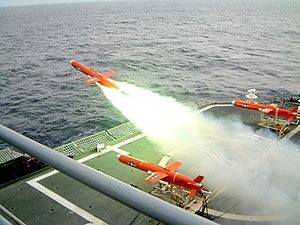Northrop BQM-74 Chukar: Difference between revisions
No edit summary |
recovery |
||
| Line 1: | Line 1: | ||
__NOTOC__ |
__NOTOC__ |
||
[[Image:BQM-74E launch.jpg|thumb|300px|right|BQM-74E Chukar launching]] |
[[Image:BQM-74E launch.jpg|thumb|300px|right|BQM-74E Chukar launching]] |
||
| ⚫ | |||
The '''[[Northrop Grumman|Northrop]] BQM-74 Chukar''' aerial target drone is a recoverable, remote controlled, subsonic aerial target, capable of speeds up to [[Mach number|Mach]] 0.86 and altitudes from 30 to 40,000 ft (10 to 12,000 m). |
The '''[[Northrop Grumman|Northrop]] BQM-74 Chukar''' aerial target drone is a recoverable, remote controlled, subsonic aerial target, capable of speeds up to [[Mach number|Mach]] 0.86 and altitudes from 30 to 40,000 ft (10 to 12,000 m). |
||
The BQM-74E is propelled during flight by a single [[Williams J400|J400-WR-404]] [[turbojet]] engine, which produces a maximum thrust of 240 pounds force (1068 N) at sea level. The BQM-74 is launched from a zero length ground launcher utilizing dual Jet Assisted Takeoff ([[JATO]]) bottles. When equipped with an air launch kit, the BQM-74 can be air launched from a [[A-4 Skyhawk|TA-4J]], [[F-16 Fighting Falcon|F-16]], [[ |
The BQM-74E is propelled during flight by a single [[Williams J400|J400-WR-404]] [[turbojet]] engine, which produces a maximum thrust of 240 pounds force (1068 N) at sea level. The BQM-74 is launched from a zero length ground launcher utilizing dual Jet Assisted Takeoff ([[JATO]]) bottles. When equipped with an air launch kit, the BQM-74 can be air launched from a [[A-4 Skyhawk|TA-4J]], [[F-16 Fighting Falcon|F-16]], [[Grumman Gulfstream I]] or [[C-130 Hercules|DC-130]] aircraft. The BQM-74 is used primarily as a realistic aerial target, capable of simulating enemy threats for gunnery and missile training exercises. |
||
{{-}} |
|||
==Recovery== |
|||
[[Image:MQM-74C Chukar II floating.jpg|200px|thumb|MQM-74C Chukar II floating, awaiting recovery.]] |
|||
Drones are capable of being recovered following a training exercise. A parachute is deployed by remote control or if the remote control link is severed and a flotation kit can be added for sea-based recovery. If recovery of the drone is required, special telemetry warheads are used on the defensive missile in place of explosives. This telemetry warhead is desirable since it allows for extensive analysis of the performance of the defensive missile, including miss distance information that determines if a real warhead would have damaged the target. A direct hit would likely destroy the drone. Gunnery systems would use non-explosive dummy munitions. Since gunnery systems are aimed in front of a moving target so it will fly through the blast-fragments, dummy munitions do not have to directly hit a target. Analysis of radar data would determine if the dummy munitions would have damaged the target drone. |
|||
{{-}} |
|||
==Specifications (Surface-launch BQM-74E)== |
==Specifications (Surface-launch BQM-74E)== |
||
| ⚫ | |||
===General characteristics=== |
===General characteristics=== |
||
* '''Crew:''' none |
* '''Crew:''' none |
||
| Line 42: | Line 47: | ||
[[AGM-76 Falcon|AGM-76]] - |
[[AGM-76 Falcon|AGM-76]] - |
||
[[FGM-77 Dragon|FGM-77]] |
[[FGM-77 Dragon|FGM-77]] |
||
==External links== |
|||
*[http://www.designation-systems.net/dusrm/m-74.html Designation-systems.net] |
|||
{{airlistbox}} |
{{airlistbox}} |
||
Revision as of 14:59, 30 July 2006

The Northrop BQM-74 Chukar aerial target drone is a recoverable, remote controlled, subsonic aerial target, capable of speeds up to Mach 0.86 and altitudes from 30 to 40,000 ft (10 to 12,000 m).
The BQM-74E is propelled during flight by a single J400-WR-404 turbojet engine, which produces a maximum thrust of 240 pounds force (1068 N) at sea level. The BQM-74 is launched from a zero length ground launcher utilizing dual Jet Assisted Takeoff (JATO) bottles. When equipped with an air launch kit, the BQM-74 can be air launched from a TA-4J, F-16, Grumman Gulfstream I or DC-130 aircraft. The BQM-74 is used primarily as a realistic aerial target, capable of simulating enemy threats for gunnery and missile training exercises.
Recovery

Drones are capable of being recovered following a training exercise. A parachute is deployed by remote control or if the remote control link is severed and a flotation kit can be added for sea-based recovery. If recovery of the drone is required, special telemetry warheads are used on the defensive missile in place of explosives. This telemetry warhead is desirable since it allows for extensive analysis of the performance of the defensive missile, including miss distance information that determines if a real warhead would have damaged the target. A direct hit would likely destroy the drone. Gunnery systems would use non-explosive dummy munitions. Since gunnery systems are aimed in front of a moving target so it will fly through the blast-fragments, dummy munitions do not have to directly hit a target. Analysis of radar data would determine if the dummy munitions would have damaged the target drone.
Specifications (Surface-launch BQM-74E)

General characteristics
- Crew: none
- Length: 12 ft 11 in (3.94 m)
- Wingspan: 5 ft 9 in (1.76 m)
- Height: 2 ft 4 in (0.71 m)
- Wing area: ft² ( m²)
- Empty: 271 lb (123 kg)
- Loaded: lb ( kg)
- Maximum takeoff: 549 lb (249 kg)
- Powerplant: 1× Williams J400-WR-404 turbojet, 240 lbf (1.1 kN) thrust
Performance
- Maximum speed: 606 mph (972 km/h)
- Range: endurance of up to 68 minutes
- Service ceiling: 40,000 ft (12,000 m)
- Rate of climb: ft/min ( m/min)
- Wing loading: lb/ft² (kg/m²)
- Thrust-to-weight:
Related content
Related development:
Comparable aircraft:
Designation sequence: BGM-71 - MIM-72 - UGM-73 - BQM-74 - BGM-75 - AGM-76 - FGM-77
